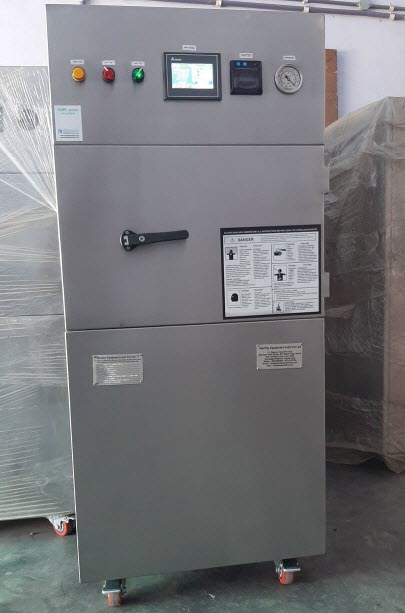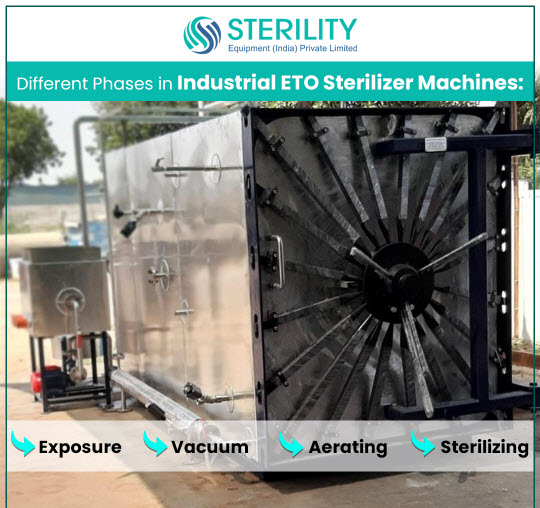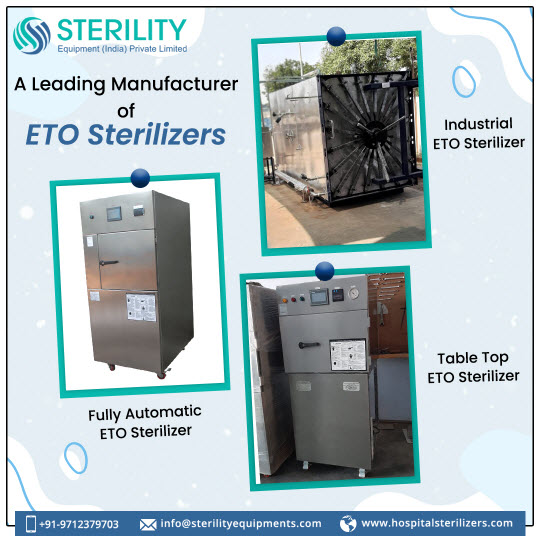Introduction to ETO Sterilizers
In this section, we will provide a comprehensive introduction to ETO sterilizers, which are vital pieces of sterilization equipment utilized across various industries. We will delve into the concept of ethylene oxide sterilization and its significant role in achieving high-level disinfection. By exploring the key features and benefits of ETO sterilizers, we will highlight how they contribute to ensuring the safety and efficacy of sterilization processes.
ETO sterilizers, also known as ethylene oxide sterilizers, are advanced equipment widely employed in diverse industries for achieving effective sterilization. Ethylene oxide sterilization involves the use of ethylene oxide gas to eliminate bacteria, viruses, and other microorganisms, ensuring high-level disinfection. This method is particularly suitable for items sensitive to high temperatures or moisture, such as medical devices, surgical instruments, pharmaceutical products, and electronic components.
The significance of ETO sterilizers lies in their ability to penetrate porous materials and complex-shaped items, thoroughly disinfecting them. The ethylene oxide gas can reach hidden areas and penetrate the packaging, ensuring the elimination of microorganisms. This makes ETO sterilizers a preferred choice in industries where traditional sterilization methods may not be sufficient.
One of the key features of ETO sterilizers is their versatility. They can accommodate a wide range of items with varying sizes and shapes, providing flexibility in the sterilization process. This adaptability makes them suitable for diverse applications, including hospitals, laboratories, pharmaceutical facilities, and food processing plants.
ETO sterilizers offer several benefits in terms of safety and efficacy. They provide a high degree of sterilization assurance by effectively killing microorganisms, including bacteria, viruses, and spores. The thorough disinfection achieved by ethylene oxide sterilization helps reduce the risk of infections and ensures the safety of patients, consumers, and workers.
Moreover, ETO sterilizers have the capability to maintain the integrity and functionality of sensitive materials and equipment during the sterilization process. This makes them particularly valuable for items that are heat or moisture-sensitive, as they can be effectively sterilized without compromising their quality or functionality.
In summary, ETO sterilizers play a crucial role in achieving high-level disinfection in various industries. Their ability to utilize ethylene oxide gas for thorough sterilization, coupled with their versatility and compatibility with a wide range of items, makes them indispensable in settings where other sterilization methods may fall short. By prioritizing the safety and efficacy of sterilization processes, ETO sterilizers contribute to maintaining high standards of quality and hygiene in healthcare, pharmaceutical, and other critical industries.
Understanding the Cost Factors
Before delving into budgeting for ETO sterilizers, it is essential to gain a comprehensive understanding of the cost factors associated with them. In this section, we will examine the various elements that contribute to the overall cost of ETO sterilizers. By exploring both one-time expenses and ongoing operational costs, we can accurately assess the financial implications of integrating ETO sterilizers into a facility’s sterilization processes.
Initial Investment
The initial investment is a crucial consideration when budgeting for ETO sterilizers. It includes the purchase price of the sterilizer itself and any associated costs such as installation, customization, and necessary infrastructure adjustments. The purchase price of ETO sterilizers can vary based on factors such as capacity, features, and brand reputation. Additionally, installation costs may involve expenses related to electrical connections, ventilation systems, and compliance with safety regulations. Understanding these one-time expenses is essential for accurate budget planning.
Operational Expenses
In addition to the initial investment, ongoing operational expenses form a significant part of the overall cost of ETO sterilizers. These expenses include utility bills, such as electricity and water usage required for the sterilization process. It is important to consider the energy efficiency and resource consumption of the sterilizer to estimate the associated operational costs accurately. Additionally, consumables like ethylene oxide cartridges, sterilization packaging materials, and other supplies contribute to the ongoing expenses. Analyzing and budgeting for these operational costs ensures a realistic financial plan.
Maintenance Costs
Maintenance costs are an integral part of the budgeting process for ETO sterilizers. Regular maintenance and servicing are necessary to ensure the sterilizer’s optimal performance, safety, and longevity. These costs encompass routine inspections, calibration, preventive maintenance, and potential repairs or replacement of parts. It is essential to consider the manufacturer’s recommendations and industry guidelines for maintenance intervals to estimate the associated costs accurately. By factoring in maintenance costs, facilities can uphold the reliability and efficiency of their ETO sterilizers.
Considering all these cost factors associated with ETO sterilizers is crucial for effective budgeting and financial planning. By evaluating the initial investment, ongoing operational expenses, and maintenance costs, facilities can develop a comprehensive budget that reflects the true financial implications of incorporating ETO sterilizers into their sterilization processes. This holistic approach enables facilities to make informed decisions, allocate resources efficiently, and ensure the long-term sustainability of their sterilization operations.

Initial Investment
The initial investment is a crucial factor to consider when budgeting for ETO sterilizers. In this subsection, we will discuss the elements that influence the purchase price of ETO sterilizers, including their size, capacity, and additional features. We will also explore financing options available to businesses, such as leasing or installment plans, to help manage upfront costs while acquiring the necessary sterilization equipment.
The purchase price of ETO sterilizers can vary depending on several factors. One such factor is the size of the sterilizer. Larger sterilizers with higher capacity tend to have a higher purchase price compared to smaller ones. The capacity of the sterilizer determines how many items can be sterilized in a single cycle, and businesses should choose a size that aligns with their operational needs.
Additionally, the inclusion of additional features can affect the purchase price. Advanced features like automated controls, digital interfaces, data logging capabilities, or specialized sterilization cycles may contribute to a higher price tag. Businesses should evaluate these features based on their specific requirements and consider the cost-effectiveness of investing in them.
When it comes to managing the initial investment, financing options can provide businesses with flexibility. Leasing is one such option where the sterilizer can be leased for a specified period, allowing businesses to access the equipment without a substantial upfront cost.
Another option is installment plans, which allow businesses to make regular payments over time to acquire the sterilizer. These financing options can help businesses allocate their budget effectively and acquire the necessary sterilization equipment without straining their cash flow.
By carefully considering the factors that influence the purchase price of ETO sterilizers and exploring available financing options, businesses can make informed decisions to manage their initial investment while acquiring the required sterilization equipment.
Operational Expenses
ETO sterilizers require ongoing operational expenses that should be accounted for in the budgeting process. This subsection will focus on the costs associated with running ETO sterilizers, including electricity consumption, water usage, utility costs, as well as the need for consumables and disposable items.
One of the significant operational expenses is electricity consumption. ETO sterilizers require energy to operate, and the amount of electricity used will depend on factors such as the size of the sterilizer, the sterilization cycles performed, and the efficiency of the equipment. It is important to assess the energy efficiency of the sterilizer and estimate the associated electricity costs accurately.
Water usage is another aspect of operational expenses for ETO sterilizers. The sterilization process may involve water for cooling, steam generation, or other purposes. Evaluating the water requirements and estimating the associated costs, including water supply and wastewater disposal, is essential for budgeting accurately.
Utility costs go beyond electricity and water. Depending on the sterilizer’s design, other utilities such as gas or compressed air may be required. It is crucial to consider these additional utility expenses to develop a comprehensive operational budget.
In addition to utility costs, businesses should factor in the cost of consumables and disposable items used in the sterilization process. ETO sterilizers often require ethylene oxide cartridges, sterilization packaging materials, and other supplies. The frequency of sterilization cycles and the volume of items processed will impact the consumption of these items and, subsequently, the operational costs.
By analyzing and budgeting for these operational expenses, including electricity consumption, water usage, other utility costs, and consumables, businesses can develop a realistic financial plan that accounts for the ongoing costs associated with running ETO sterilizers.
Maintenance and Servicing
Maintaining and servicing ETO sterilizers is vital for their optimal performance and longevity. In this subsection, we will delve into the costs associated with regular maintenance and servicing of ETO sterilizers, including routine inspections, calibration, potential repairs, and spare parts.
Regular maintenance is essential to ensure that ETO sterilizers operate at their best. This includes routine inspections to identify any potential issues or wear and tear. Calibration of the sterilizer’s controls and sensors is also crucial to maintain accurate and reliable sterilization processes. These maintenance activities help prevent breakdowns, ensure consistent performance, and prolong the equipment’s lifespan.
In some cases, repairs or replacement of parts may be necessary. Over time, certain components of the sterilizer may require servicing or replacement due to normal wear and tear or unexpected failures. The costs associated with these repairs or replacement of parts should be considered in the budgeting process.
Understanding the importance of maintenance and factoring in the associated costs is crucial for businesses to ensure the reliability and efficiency of their ETO sterilizers. It is recommended to work with experienced technicians or service providers specialized in ETO sterilizers for efficient and reliable maintenance and servicing.
By including maintenance and servicing costs in the budget, businesses can proactively manage the upkeep of their ETO sterilizers, minimize downtime, and ensure that the equipment consistently delivers optimal sterilization results.

Cost Analysis and ROI Calculation
In this section, we will conduct a comprehensive cost analysis and ROI calculation for ETO sterilizers. By considering the initial investment, operational expenses, and maintenance costs, we will help businesses understand the long-term financial implications of integrating ETO sterilizers into their operations. Additionally, we will discuss the concept of return on investment and how it can be measured in the context of ETO sterilization equipment. A cost-benefit analysis will provide valuable insights into the economic feasibility of ETO sterilizers.
Integrating ETO sterilizers into a facility’s operations involves a substantial investment, and conducting a cost analysis is crucial to assess its financial impact. The cost analysis includes evaluating the initial investment, ongoing operational expenses, and maintenance costs over the expected lifespan of the equipment.
The initial investment consists of the purchase price, installation costs, and any necessary infrastructure adjustments. By carefully assessing these costs, businesses can determine the capital expenditure required to acquire and set up the ETO sterilizers.
Operational expenses encompass ongoing costs such as utility bills, consumables, and other operational necessities. It is important to estimate these expenses accurately, considering factors such as electricity consumption, water usage, and the volume of consumables required for regular sterilization processes.
Maintenance costs are another component of the cost analysis. Regular maintenance, inspections, calibration, and potential repairs or replacement of parts contribute to these costs. Factoring in these expenses allows businesses to anticipate the long-term investment needed to maintain the reliability and performance of the ETO sterilizers.
Once the cost analysis is complete, businesses can evaluate the return on investment (ROI) associated with ETO sterilizers. ROI measures the profitability and financial benefits gained from the investment. It is calculated by comparing the gains or savings generated by the sterilization equipment against the investment costs.
To calculate ROI, businesses can consider various factors, such as reduced costs associated with outsourcing sterilization services, improved efficiency in sterilization processes, reduced risk of product contamination or recalls, and potential revenue increase from enhanced product quality and customer trust. These factors contribute to the overall value proposition of ETO sterilizers.
A cost-benefit analysis further helps businesses assess the economic feasibility of integrating ETO sterilizers. By comparing the costs and benefits over the expected lifespan of the equipment, businesses can make informed decisions regarding the investment. The analysis may include both quantifiable factors, such as cost savings and revenue increase, as well as qualitative factors, such as improved quality and compliance.
By conducting a comprehensive cost analysis, calculating ROI, and performing a cost-benefit analysis, businesses can gain valuable insights into the financial implications of integrating ETO sterilizers into their operations. This information enables informed decision-making, aligns budgeting strategies with long-term goals, and ensures the optimization of resources for enhanced operational efficiency and profitability.
Planning and Budgeting Strategies
To successfully budget for ETO sterilizers, organizations need effective planning and budgeting strategies. In this section, we will provide practical guidance on developing a budgeting plan tailored to the specific needs and goals of businesses. We will explore financial strategies, such as phased implementation or seeking expert advice, to optimize costs and ensure the affordability of ETO sterilizers without compromising quality or safety. Additionally, we will discuss the importance of regularly reviewing and adjusting the budget to adapt to changing circumstances.
Developing a comprehensive budgeting plan is crucial when integrating ETO sterilizers into an organization’s operations. The following strategies can help organizations optimize costs and ensure the affordability of ETO sterilizers:
Assess Needs and Goals: Begin by assessing the specific needs and goals of the organization regarding sterilization. Consider factors such as the volume of sterilization required, the types of items to be sterilized, and any regulatory or industry-specific requirements. Understanding these factors will help determine the appropriate size and capacity of the ETO sterilizers needed.
Phased Implementation: Implementing ETO sterilizers in a phased manner can help manage costs effectively. Start with essential sterilization areas or critical items, and gradually expand the implementation based on budget availability and operational priorities. This approach allows organizations to spread out the investment and align it with their financial capabilities.
Financial Expertise: Engage financial experts or consultants with experience in healthcare or medical equipment to guide the budgeting process. These professionals can provide valuable insights, help identify potential cost-saving opportunities, and assist in developing a realistic financial plan.
Vendor Evaluation: Thoroughly evaluate different vendors and suppliers to ensure competitive pricing without compromising quality. Obtain multiple quotes, review the reputation and track record of the suppliers, and consider factors such as after-sales service and warranty provisions. A well-informed vendor selection can contribute to cost optimization and ensure long-term support.
Cost Optimization: Explore opportunities to optimize costs associated with ETO sterilizers. This can include negotiating favorable financing terms, leasing options, or exploring potential grants or funding available in the healthcare or research sectors. Additionally, consider energy-efficient models or equipment with features that streamline processes and reduce operational expenses.
Budget Review and Adjustments: Regularly review and adjust the budget to adapt to changing circumstances. Factors such as fluctuating utility costs, evolving regulatory requirements, or unexpected maintenance needs may necessitate adjustments to the budget. By conducting periodic reviews, organizations can ensure that their budget remains aligned with their goals and financial capacities.
By incorporating these planning and budgeting strategies, organizations can effectively manage the integration of ETO sterilizers into their operations. A well-thought-out budgeting plan ensures affordability, supports the organization’s sterilization needs, and promotes cost optimization without compromising quality or safety.






